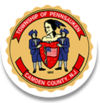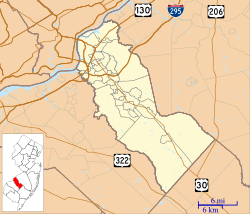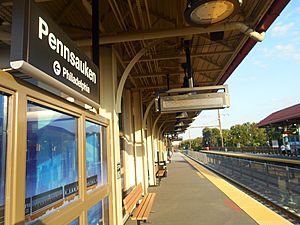Pennsauken Township, New Jersey facts for kids
Quick facts for kids
Pennsauken Township, New Jersey
|
||
|---|---|---|
|
Township
|
||
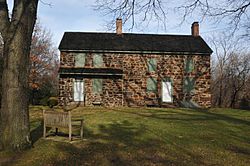
Burrough-Dover House
|
||
|
||
| Motto(s):
A Great Place to Grow, Dream and Prosper!
|
||
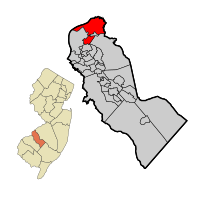
Location of Pennsauken Township in Camden County highlighted in red (right). Inset map: Location of Camden County in New Jersey highlighted in orange (left).
|
||
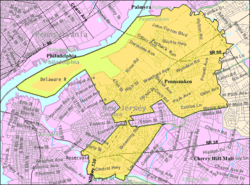
Census Bureau map of Pennsauken Township, New Jersey
|
||
| Country | ||
| State | ||
| County | Camden | |
| Incorporated | February 18, 1892 | |
| Government | ||
| • Type | Township | |
| • Body | Township Committee | |
| Area | ||
| • Total | 12.13 sq mi (31.41 km2) | |
| • Land | 10.48 sq mi (27.14 km2) | |
| • Water | 1.65 sq mi (4.27 km2) 13.59% | |
| Area rank | 189th of 565 in state 5th of 37 in county |
|
| Elevation | 89 ft (27 m) | |
| Population
(2020)
|
||
| • Total | 37,074 | |
| • Estimate
(2023)
|
37,288 | |
| • Rank | 66th of 565 in state 5th of 37 in county |
|
| • Density | 3,537.9/sq mi (1,366.0/km2) | |
| • Density rank | 190th of 565 in state 23rd of 37 in county |
|
| Time zone | UTC−05:00 (Eastern (EST)) | |
| • Summer (DST) | UTC−04:00 (Eastern (EDT)) | |
| ZIP Codes |
08109–08110
|
|
| Area code | 856 | |
| FIPS code | 3400757660 | |
| GNIS feature ID | 0882157 | |
Pennsauken Township is a community in Camden County, New Jersey. It's part of the larger Philadelphia Metropolitan Area. Pennsauken is right next to Philadelphia, Pennsylvania, and shares a border along the Delaware River.
In 2020, about 37,074 people lived in Pennsauken. This number has grown a bit over the years.
Contents
History of Pennsauken Township
Pennsauken Township officially became a township on February 18, 1892. It was formed from parts of another area called Stockton Township.
The name "Pennsauken" might come from the Lenni Lenape Native Americans. They used to live in this area. One idea is that it comes from their word "Pindasenauken," which means "tobacco pouch." Another idea is that "Penn" refers to William Penn, and "sauk" means a water inlet or outlet.
Pennsauken was home to a very cool invention: America's first drive-in movie theater! It opened in 1933 and was called the Camden Drive-In. People could watch movies from their cars.
For 50 years, Pennsauken also had a big indoor market called the Pennsauken Mart. It closed in 2006, and now there's a fancy apartment complex where it used to be.
Geography and Location
Pennsauken Township covers about 12.13 square miles (31.41 square kilometers). Most of this is land, but some is water, like parts of the Delaware River.
You might hear of smaller areas within Pennsauken, like Delair, Dudley, and Hillcrest. These are all part of the township.
A special place in Pennsauken is Petty's Island. It's a 392-acre island in the Delaware River. It used to be used for storing oil, but now it's becoming a new state park and nature center. It's also a home for bald eagles!
Pennsauken is connected to Philadelphia, Pennsylvania, by the Betsy Ross Bridge. This bridge crosses the Delaware River. In New Jersey, Pennsauken shares borders with several other towns. These include Camden, Cherry Hill, and Merchantville in Camden County. It also borders Cinnaminson Township, Maple Shade Township, and Palmyra in Burlington County.
Climate in Pennsauken
Pennsauken has a humid subtropical climate. This means it has hot, humid summers and mild winters. The hottest temperature ever recorded in Pennsauken was 108°F (42°C) on July 16, 1995. The coldest temperature recorded was -4°F (-20°C) in January 1994.
Population and People
| Historical population | |||
|---|---|---|---|
| Census | Pop. | %± | |
| 1900 | 3,145 | — | |
| 1910 | 4,169 | 32.6% | |
| 1920 | 6,474 | 55.3% | |
| 1930 | 16,915 | 161.3% | |
| 1940 | 17,745 | 4.9% | |
| 1950 | 22,767 | 28.3% | |
| 1960 | 33,771 | 48.3% | |
| 1970 | 36,394 | 7.8% | |
| 1980 | 33,775 | −7.2% | |
| 1990 | 34,738 | 2.9% | |
| 2000 | 35,737 | 2.9% | |
| 2010 | 35,885 | 0.4% | |
| 2020 | 37,074 | 3.3% | |
| 2023 (est.) | 37,288 | 3.9% | |
| Population sources: 1900–2000 1900–1920 1900–1910 1910–1930 1940–2000 2000 2010 2020 |
|||
In 2010, the population of Pennsauken was 35,885 people. The township had 12,633 households. The average household had about 2.83 people. The median age of people living in Pennsauken was 38 years old.
Economy and Businesses
Pennsauken has a large area with many businesses and factories. Some well-known companies here include a Pepsi bottling plant and J & J Snack Foods.
Education in Pennsauken
The Pennsauken Public Schools serve students from pre-kindergarten all the way through twelfth grade. There are 10 schools in the district.
- Elementary Schools: G. H. Carson, Delair, George B. Fine, and Benjamin Franklin Elementary Schools teach students from kindergarten to 3rd grade. There's also the Baldwin Early Childhood Learning Center for Pre-K.
- Intermediate School: Pennsauken Intermediate School is for 4th and 5th graders.
- Middle School: Howard M. Phifer Middle School serves students in grades 6-8.
- High Schools: Students in grades 9-12 attend Pennsauken High School. There's also the Alfred E. Burling Alternative High School.
Pennsauken also has the Pennsauken Technical High School. This school offers special technical and vocational training to students from all over the county.
For private education, there's Eustace Preparatory School, which is a high school for grades 9-12. St. Cecilia School is a Catholic elementary school for grades K-8.
Transportation Options
Pennsauken has many roads and highways that help people get around. The biggest highway is Route 130. Other important roads include Route 73, Route 90, New Jersey Route 38, and Route 70. These roads connect Pennsauken to nearby towns and cities.
For public transportation, Pennsauken has three NJ Transit train stops:
- The Pennsauken-Route 73 and 36th Street stations are on the River Line. This line goes between Trenton and Camden.
- The Pennsauken Transit Center is a special station where you can switch between the River Line and the Atlantic City Line. The Atlantic City Line connects to Philadelphia and Atlantic City. This station opened in 2013.
There are also many NJ Transit bus routes that serve Pennsauken. Some buses go to Philadelphia, while others travel within New Jersey.
Notable People from Pennsauken
Many interesting people have lived in or are connected to Pennsauken Township. Here are a few:
- 3Breezy (born 1999), a rapper, singer, and songwriter.
- Harold Amos (1918–2003), a microbiologist and professor at Harvard Medical School.
- Dotty Attie (born 1938), a feminist painter whose art is in famous museums.
- Albert E. Burling (1891–1960), who was a Justice on the New Jersey Supreme Court.
- Bill Conaty (born 1973), a former professional American football player.
- Jack Conners (born 1943), a politician who served in the New Jersey General Assembly.
- Mary Keating Croce (1928–2016), a politician who served in the New Jersey General Assembly.
- Krysten Cummings (born 1974/75), a film and stage actress.
- Ron Curry (born 1993), a professional basketball player.
- Eric Dezenhall (born 1962), a crisis management consultant and author.
- George Dempsey (1929–2017), a former professional basketball player for the Philadelphia Warriors.
- Vice Admiral Nanette M. DeRenzi, a high-ranking officer in the United States Navy.
- Al Fisher (born 1986), a basketball player who was named MAC Player of the Year.
- Carmen M. Garcia, a former Chief judge in Trenton, New Jersey.
- Bill Gosper (born 1943), a mathematician and computer programmer.
- David Griggs (1967–1995), a former NFL linebacker.
- Dwight Hicks (born 1956), a former player for the San Francisco 49ers.
- Todd McNair (born 1965), a former NFL running back.
- Bill Melchionni (born 1944), a former NBA and ABA basketball player.
- Donald Norcross (born 1958), a politician who represents New Jersey in Congress.
- Jamal Parker (born 1998), a professional gridiron football player.
- Delia Parr, an author of historical fiction books.
- Steven M. Petrillo (born 1958), a politician who served in the New Jersey General Assembly.
- Gary Schaer (born 1951), a politician who serves in the New Jersey General Assembly.
- Frank Seward (1921–2004), a pitcher who played for the New York Giants.
- Stephen M. Sweeney (born 1959), a New Jersey State Senator and former Senate President.
- John Taylor (born 1962), a wide receiver for the San Francisco 49ers.
- Keith Taylor (born 1964), a former NFL safety.
- Jersey Joe Walcott (1914–1994), a world heavyweight boxing champion.
- William Wesley (born 1964), an NBA basketball player associate.
- Darrell Wilson (born 1958), an American football coach.
See also
 In Spanish: Municipio de Pennsauken para niños
In Spanish: Municipio de Pennsauken para niños


